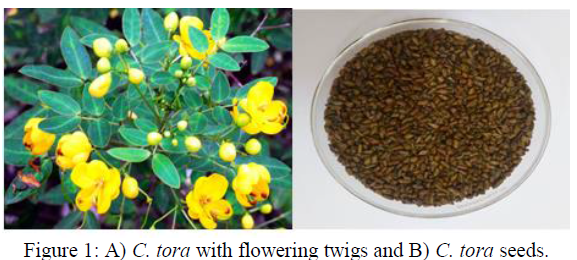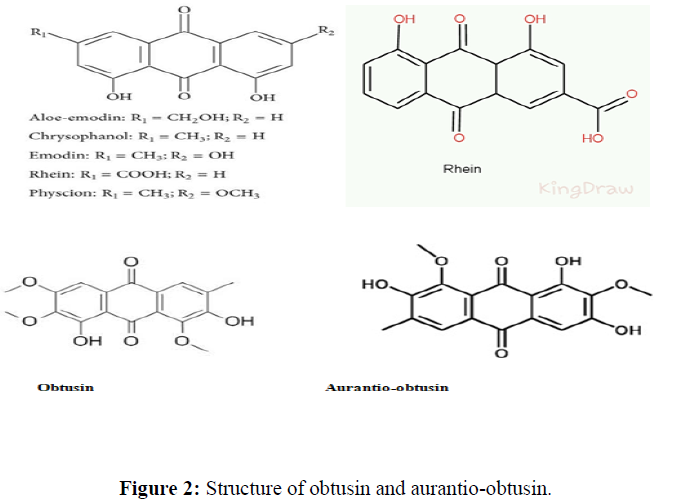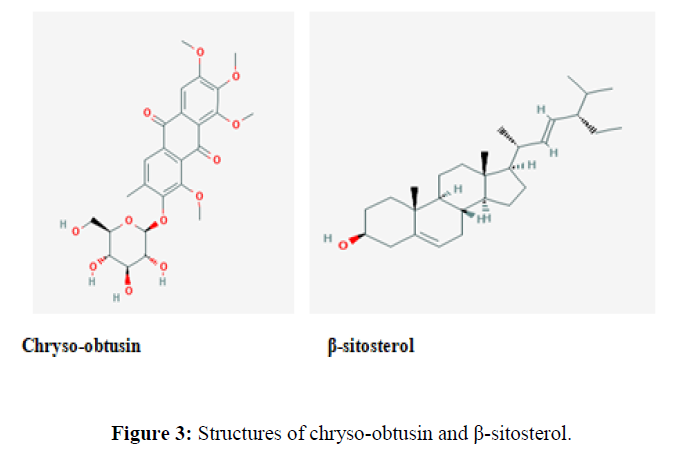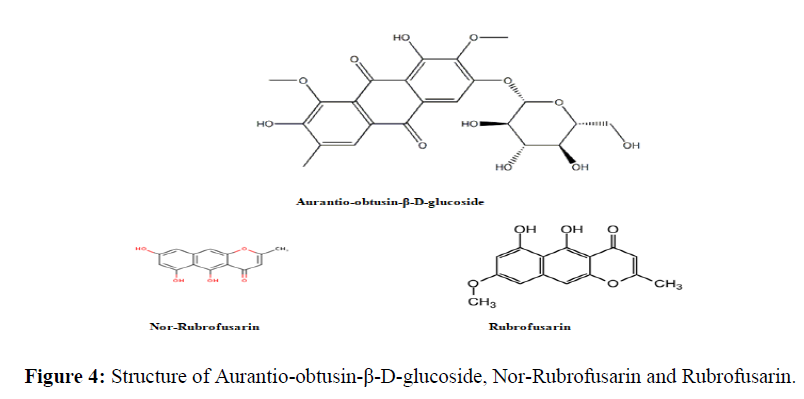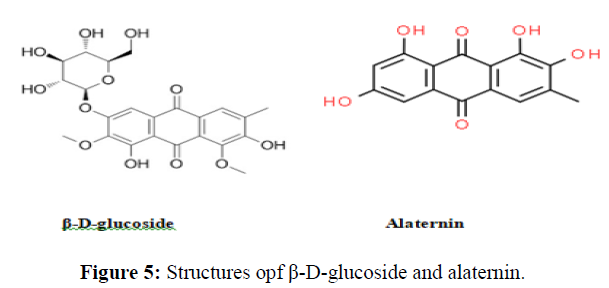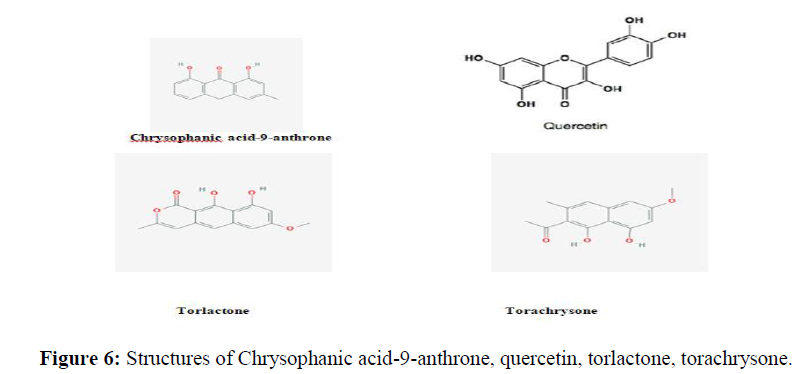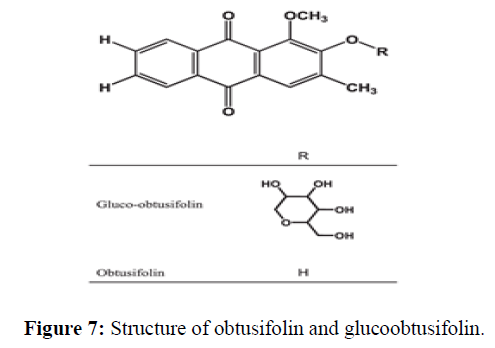Review Article - Der Pharma Chemica ( 2021) Volume 13, Issue 11
Phytochemistry and Potential Benefits of Cassia Tora Linn: A Review.
Sanjay Krishna Pandey, Jai Narayan Mishra and Dhaneshwar K. Vishwakarma*Dhaneshwar K. Vishwakarma, Department of Pharmacy, Kailash Institute of Pharmacy and Management, Gorakhpur, India, Email: dkvpharmaguidance@gmail.com
Introduction
The rate of occurrence of fungal infections is increasing day by day hence they poses critical conditions to medical professionals. Although today a lot of medicines are there for the treatment of fungal infections but they bear too many side effects including development of resistance too. Therefore, to deal with these challenges investigators are trying to explore traditional medicines available throughout world. And in comparison to modern drugs these drugs bears less adverse effects and also they are easy to purchase. One such plant found effective for skin infections and especially for ringworm is cassia tora Linn. Nature has provided us a lot of useful plant. Many of them are enriched with powerful substances beneficial for human beings [1]. Such medicinally active plants give a way to synthesize different active principle. India is one of such country that possesses a lot of medicinally active herbs, trees, shrubs that may be used for ailment of various diseases. As per WHO 70% of world’s population is dependent on traditionally found medicines for fighting with their health issues as well as disease. Species cassia belongs to one such plant that possesses very wide active constituents. The plant is traditionally well known for the treatment of conditions like hypertension, diabetes skin disease, cough, pulmonary problems, and stomach problem etc [2]. Interestingly the genus cassia consists of 580 species of trees, herbs and shrubs. Among various spp. of cassia important ones are C. auriculata, C. fistula, C. italica, C. javanica, C. siamea, C. spectabilis. C. alata, C. nodosa, C. tora, C. sophera, C. nigricans, C. angustifolia, C. renegera and C. australis. Since due to widespread incidence of skin disease among population the plant cassia was felt effective for undertaking the formulation development.
Literature Review
Plant Profile
Common name of the plant: In Hindi chakavat, chakunda,panevar, in Marathi Takla, tankli,tarota; in Bengali Panevar, chakunda; in Tamil tagarai, senavu, vindu;in Rajasthani Chakuada, panwar, pumaria; in Gujarati Kawario, konariya; in Sanskrit chakramarda, dadamari, prishnaparni,tellakasinda; in Jammu haedma; in Madhya Pradesh carota,halbi; in Punjab chakunda, panwar, pawas; in Tripura chakunda,goel-eski in Oriya chakunda. It is also known commonly as sickle Senna due to sickle shape of the plant fruit [3].
Botanical features
C. tora is a stout, erect, smooth semi woody annual herb one-two meter in height. Leaves 6.0-12.5 cm long, leaflets 3 in pairs, 3-5 cm long, membranous, ovate-oblong, with subulate glands in the last two pairs, showing sleepy movements at night; The flowers are bright yellow in colors, usually in pairs, on very short axillary peduncles; pods stout 4-angle, 15-25 cm long; seeds green.
Occurrence
The plant occurs as a weed spreading up to an altitude of 1450 m in Himalaya regions. Found distributed wildly in UP, Bihar, Rajasthan, Orissa, Maharashtra, Bengal, Punjab and plains of Tamil nadu.
Useful portions of the plant
Rootlet, Leaflets and Seeds.
Spreading and planting
The plant can be easily cultivated grown by means of seeds.
Cassia Tora: Seed (Description)
• Macroscopical peculiarities
• Color-light brown
• Odour-odourless
• Taste-bitter
• Size-length 3-6 mm
• Thickness 2-4 mm
• Shape-elongated, ovoid and obliquely pointed
• Texture-smooth
Microscopical aspects
Outer integument: Epidermis: single layered, polygonal tubular cells, Sub-epidermis: one or two layers of cylindrical collenchyma.
Inner integument: Sclerenchymatous layer-elongated longitudally, sclerieds are lignified; 110-180μ long and 13-16 μ wide, walls are thick with small lumen Parenchymatous layer-1-2 layered, elongated tangentially. Pigment layer- single layered, polygonal cells, red brown pigments. Endosperm-cells are polyhedral, oily globules and aleuronic granules. Cotyledon-cells are polyhedral. Seed powder
• Organoleptic qualities.
• Color-brown.
• Odor- odorless.
• Taste-bitter.
Phytochemistry
Various authors have reported that different part of the plant contains different constituents. The leaves of the plant contains Emodin, tricontain-1-ol, stigmasterol, β-sitosterol-β-D-glucoside, succinic acid, tartaric acid, uridine, quercetin, isoquercitin. Also leaves and seeds contains anthraquinones as chrysophanol, physcion, emodin, rhein, obtusifolin, obtusin, chyrso-obtusin, rubrofusarin, aurantio-obtusin, chysophanic acid-9-anthrone. From seed extract phenolic glycoside like triglucoside, nor-rubrofusarin, gentiobioside torachysone, toralactone, and alaternin have been isolated. The butanol soluble extract of the seeds of the plant contains three naphthopyrone glucosides-cassia side, rubrofusarin-6-o-β-gentiobioside and toralactone-9-o-β-D-gentiobioside [4].
Seed extract have also demonstrated the presence of anthraquinones derivative like 1-desmethylaurantio-obtusin and 1-desmethylchryso-obtusin. The gum extracted from the seeds of cassia tora contains 70% high m.wt. Polysaccharide with a liner chain of 1, 4-β-D-mannopyarnose linked to 1,6-linked α-D-galactopyranose unit. The composition of saccharide were mannose (78-79%), galactose (16-17%) and glucose(7.5-8%) Cassia tora leaves were also evaluated to find out proximate nutrient content, amino acid composition, and some special mineral element. Result showed the presence of 11.25% of crude protein,28.00% of crude fibre protein.17 amino acids were also found to be present in extract The various element were Ca 3.45 gm, Fe 0.25 gm, Na 0.11 gm, Mg o.85 gm, Na 0.03 gm, Mn 0.11 gm, Co 0.01 gm, K o.75 gm, etc.
Potential beneficial activities of c. Tora plant extract
Antifungal and antibacterial activity: Different studies have suggested that the plant has antifungal activity. The chief antifungal component identified was Chrysophanic acid-9- anthrone.The compound has prevented the growth of Trichophyton rubrum, T. mentagrophytes, Microsporum canis, M. gypseum, and Geotrichum candidum in broth culture in presence of an antioxidant L-Ascorbic acid at 95.5 μg/ml. In one study ethanolic extract of plant seed showed inhibition of the growth of C. albicans with inhibition zone of 8.5 mm diameter at 24 mg/ml and 11.0 mm diameter at 29 mg/ml. Ethanolic and aqueous extract from the leaves of c.tora had been observed for the antibacterial activity in zone of inhibition at 0.15 mg and 0.30 mg doses respectively. The extract showed pronounced antibacterial activity when compared with the standard reference drug ciprofloxacin [5].
Hepatoprotective activity: In an experimental study, carbon tetrachloride induced liver damage in albino rats was decreased by orally administered leaf extract at dose of 100-600 mg/kg body weight. Study showed that the extract has raised the level of SGPT, SGOT, ALP, and the production of melanoaldehyde. In other study, Galactosamine induced liver damage in rats were carried out using antihepatotoxic naphthopyrone glycosides, 6-[(α-apio-furanosyl-(1,6)-O-β-D-glucopyranosyl)oxy]-rubrofusarin and 9-β-D-glucopyranosyl)oxy]-10-hydroxy-7-mehoxy-3-methyl-1H-naphtho [2,3-c] pyran-1-one together with cassiaside and rubrofusarin-6-β-D-gentiobioside isolated from seeds showed strong Hepatoprotective effect which was comparable higher than Silybin isolated from Silybum marianum Gaertn [6].
Antihyeprlipidemic activity: An experimental study was carried out by Patil. On trton induced hyperlipidemic profile with ethanolic extract of seeds. Both the ether soluble and water soluble fraction of ethanolic extract lowered the serum and triglyceride level of total LDL- cholesterol but increased the HDL-cholesterol level by different proportions. In an experiment the soluble fibre of seeds were tested for their hypolipidemic effect. It was demonstrated that they reduced serum level of cholesterol and triglyceride but enhanced the level of high density lipoprotein. It was observed due to increased fecal lipid excretion in rats [7]. In another study the seed extract reduced serum level of total cholesterol by 40.04, 40.55 and 70.25% respectively.
Larvicidal activity: Methanolic extract of seeds of plant has shown Larvicidal activity against Aides agypti mosquito which spreads dengue fever and culex pipiens mosquito that spreads Japanese encephalitis in a dose dependent manner.
Antiplasmodial activity: The plant extract showed in-vitro Antiplasmodial activity against chloroquine sensitive Plasmodium falciparum [8].
Anti-inflammatory activity: In an study conducted by chaurasia the antidiabetic screening of methanol extract of seeds of c.tora using single dose and prolonged treatment in normal and alloxan induced diabetic albino rats were evaluated. It was observed that when methanol extract was given at doses of 50,100 and 200mg/kg body weight orally the antidiabetic efficiency were good in normal, acute and prolonged treatment group especially at 200 mg/kg body weight. The study was conducted using the standard drug Glibenclamide
Antimutagenic activity: In an study the Antimutagenic potential of methanol seed extract was observed against aflatoxin B1 (AFB1) using S. typhimurium assay and N-methyl-N,-nitrosoguanidine assay method. The numbers of mutant in each case were lowered enormously with methanol extract using S.typhimurium TA100 and TA98 assay methods. It was seen that pure compound isolated form n-butanol fraction of methanol seed extract possesses good Antimutagenic activity while its aqueous fraction was inactive.
The direct acting mutagen N-methyl-N,-nitrosoguanidine could not be inhibited both by Methanolic extract as well as by aqueous fraction when the methylene chloride and n-butanolic fraction of Methanolic extract of seeds were partitioned by column chromatography using silica gel, they yielded pure chrysophanol, chryso-obtusin and aurantio-obtusin and rubrofusarin gentiobioside and cassiaside. Each of these compound exhibited marked Antimutagenic potential.
Immunostimulatory activity: Also Benzo pyrene induced DNA damage in human hepatoma cell linenHepG2 were significantly reduced by aqueous seed extract of C. tora using the comet assay method. The inhibitory effects were 70%, 60% and 20% with unroasted, roasted at 1500°C and roasted at 2500°C at concentration of 1mg/ml. The Benzo pyrene induced damage in hepatoma cell line G2 were inhibited by chrysophanol, emodin and rhein in a ratio of 75, 88 and 70% with unroasted, roasted at 1500°C and roasted at 2500°C at 1μM.
Antioxidant activity: In one study it was demonstrated that Methanolic and aqueous extract of seed showed antioxidant effect on peroxidation of linoleic acid. When compared with α-tocopherol, the Methanolic extract of seeds demonstrated strong antioxidant effect but weaker than butylated hydroxyanisole. The fraction of methanol extract obtained from methanol-water eluent solvent showed strong antioxidant effect and was found to be due to 1,3,8-trihydroxy-6-methyl-9,10-anthracene dion as was confirmed by UV, HPLC, IR, MS and NMR analysis.
In another study radical scavenging components were isolated from seeds. 1-H and 13C-NMR data analysis showed that they are anthraquinones, alaternin and two naphthopyrone glycosides, norrubrofusarin-6-β-D-glucoside (cassiaside) and rubrofusarin-6-D-gntiobioside. The Radical chosen for study was 1,1-diphenyl-2-picrylhydrazyl (DPPH). The result showed that alaternin has marked radical scavenging activity than other components.
Anthelmintic activity: In an experiment, it was observed that al coholic and aqueous extract of seed possess anthelmintic activity against Pheretima posthuma and Ascaris galli. This activity was due to presence of flavonoids. In the study three concentrations of each extract (25, 50, 100 mg/ml) were used which involved the time of paralysis and time of death of the worm. The anthelmintic activity was seen at higher concentration (100 mg/ml) using Piperazine citrate in same concentration and distilled water as control.
Hypotensive activity: In his experiment, Koo demonstrated the hypotensive action of the seed extract in anesthetized rats. He noticed in pentobarbital-anesthetized rats, that the medial portion of the medullary reticular formation is directly involved in the hypotensive effect of the extracts.
Antishigellosis activity: Different fractions of petroleum ether extract were studied for Antishigellosis activity. It was found that ethyl acetate fraction showed maximum zone of inhibition varying from 22-26 mm at the concentration of 200 μg/disc. The minimum inhibitory concentration was found for ethyl acetate fraction to be 30-60 μg/ml.
Purgative activity: Studies carried out on methanolic leaf extract of c.tora suggest the purgative action of it. The use of seeds as purgative is due to presence of emodin, aloe-emodin and anthraquinones glycosides.
Anti-SARS-CoV activity: In a study the dried seed powder extract of C. tora (CTH) was found effective for the treatment of SARS-CoV. In this study a cell based Cytopathogenic Effect (CPE) assay in SARS-CoV-infected vero-E6 cells were used for selecting more than 200 extracts for candidates having anti-SARS-CoV activity. The CTH showed marked activity at 200 μg/ml. This activity was found better than that claimed for Glycyrrhizin, a compound reported with anti-SARS-CoV-activity.
| S. No. | Part of the Plant | Activity |
|---|---|---|
| 1 | Seed extract | Antifungal |
| 2 | Seed extract | Antibacterial |
| 3 | Leaf extract | Hepatoprotective |
| 4 | Seed extract | Antihyeprlipidemic |
| 5 | Seed extract | Larvicidal |
| 6 | Seed extract | Antiplasmodial |
| 7 | Leaf extract | Anti-inflammatory |
| 8 | Leaf extract | Anti-nociceptive |
| 9 | Seed extract | Antidiabetic |
| 10 | Seed extract | Antimutagenic |
| 11 | Seed extract | Antioxidant |
| 12 | Seed extract | Anthelmintic activity |
| 13 | Seed extract | Hypotensive activity |
| 14 | Seed extract | Antishigellosis activity |
| 15 | Leaf and Seed extract | Purgative activity |
| 16 | Seed extract | Anti-SARS-CoV activity |
Conclusion
The aim of present article was to provide an insight into the potential medicinal benefits of the plant C.tora L. For this purpose various journals and authenticated sources were used. The article not only provides considerable evidence in support of uses of the plant but also makes a strong basis for further investigation of new bioactive compounds reported so far from this plant. However, to extract the full benefits of the plant we need proper research, clinical trials as well as public awareness.
Acknowledgements
Author is highly thankful to Management, Kailash Institute of Pharmacy & Management, Gorakhpur (UP) for providing necessary facilities to complete this review article.
References
- Meena AK, Niranjan US, Yadav AK, et al. J Pharm Res, 2010, 3: p. 557-560.
- Shibata S, Morishita E, Kimura Y, Chem Pharm Bull, 1969, 17: p. 454-457.
- Choi JS, Lee HJ, Kang SS, Arch Pharma Res, 1994, 17: p. 462-466.
- Zhu L, Zeng X, Zhao M, Sep Purif Technol, 2008, 63: p. 665-669.
- Hallagan JB, Pariza MW, Putnam JM, Food Chem Toxic 1997, 35: p. 625-632.
- Panda NP, Ray P. Ian J Exp Biol Sci, 2012, 3: p. 175-179.
- Guan Y, Zhao S, J Trad Med, 1995, 15: p. 178.
- Clauson GA, Immun Pathol Res, 1989, 8: p. 104-112.

